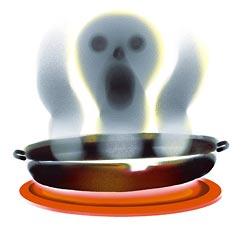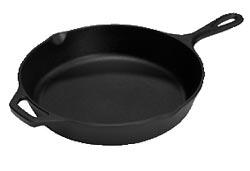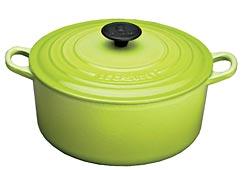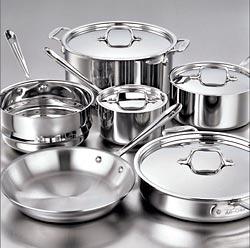Playing It Safe

SINCE WHEN DID having a kitchen require a degree in health and safety? Just when I figured out how to avoid mad-cow beef and high-mercury fish, now I'm weighing the potential health risks of my pots and pans. Because of reports that overheated Teflon pans may release toxic gases and the possible association between aluminum and Alzheimer's disease, I am cleaning out my kitchen. It's a fine line between being a smart, health-conscious consumer and being downright paranoid.
For starters I called Aaron Wright, executive chef at Seattle's Canlis Restaurant, for a reality check. Am I just an over-anxious mom in an overly toxic world? It turns out that the chefs at Canlis don't use any aluminum or nonstick cookware; they use only stainless-steel pans. "It's a lifestyle choice," Wright says. "Everything you put in your body counts. Everything matters. Look at how much money some people spend on the latest sporting gear versus having a well-equipped, healthy kitchen for their family and friends." He often gives advice about what pans to buy. "When buying stainless pans, the heavier the better. They'll last longer, and your food won't burn as quickly. When cooking, make sure that not only your pan is hot but your oil is as well. Smoking points of oils vary, so control the heat and remove the pan when it gets too hot."
Wright added that nothing should ever stick in a stainless pan. "If it does, it's a sign that the pan and the oil weren't hot enough."
With chef Wright's validation, I first considered my aluminum bakeware. Ubiquitous in today's kitchen, aluminum is cheap, lightweight and abundant. It helps heat come on fast and transfer evenly. In 2004, aluminum cookware accounted for nearly $500 million in sales, according to the Cookware Manufacturers Association.
The association Web site says aluminum poses no health risk. And a 1990 memo from the U.S. Food and Drug Administration says the normal dietary intake of aluminum is not harmful. But aluminum is neurotoxic and may be one of the causes of Alzheimer's disease, says "The Safe Shopper's Bible: A Consumer's Guide to Nontoxic Household Products, Cosmetics and Food" (Wiley Publishing, 1995).
What to believe, what to do?
At the very least, we know aluminum is reactive, so highly acidic foods like tomatoes and rhubarb should not be cooked in it. Martha Stewart suggests lining aluminum baking sheets with parchment paper when working with acidic foods. (Parchment: It's a good thing.) If you use aluminum pots and pans, keep them in good condition and replace them if they are pitted or worn. To prevent absorption, don't store foods in aluminum.
An alternative is anodized aluminum, which has a hard, non-reactive coating. The manufacturer of Calphalon, a leading brand of anodized aluminum cookware, claims the coating seals aluminum, preventing any leaching into food, according to the FDA report. This is a good choice for acidic foods. Seattle's City Kitchens carries this line.
Like chef Wright, the cookware buyer for Sur La Table's 56 stores, Jacob Maurer, suggests stainless-steel pots and pans such as All-Clad. Nearly half of Sur La Table's total cookware sales comes from pans like these with tri- or multi-ply construction: The outside layers are stainless steel and the inside, or middle, layer is aluminum. Maurer says this construction gives customers the excellent heat conductivity of aluminum without the possible health risks. And stainless steel is easy to clean.
The "Cadillac of cookware" is copper, says Maurer, because it is the best conductor of heat. If the expense or maintenance of copper is a deterrent, then stainless multi-ply is a great option — although still not cheap. A stainless 2-quart pot will run you about $75 to $130. Enameled cast-iron pans such as those from Le Creuset are also great choices from both a culinary and health perspective (the Le Creuset 2-quart round French oven runs about $70).
Next I turned to the sticky issue of nonstick cookware. The nonstick revolution in recent decades may have made omelets and cookies a lot easier but introduced a new set of artificial materials into our kitchens. Teflon is the brand name for a slippery substance called polytetrafluoroethylene, discovered by DuPont scientists in 1938 and used during World War II. (Kind of makes you wonder.) In 1960 the FDA approved its use for "food contact surfaces" and almost overnight nonstick skillets, waffle irons and cake pans filled American kitchens. Not only is it convenient, but the obvious health benefit of nonstick is that it allows you to use less oil and butter.
However, Teflon and other nonstick surfaces such as Silverstone can emit toxic fumes at high heat. DuPont recommends a maximum temperature of 500 degrees and says that "significant decomposition of the coating will occur only when temperatures exceed about 660 degrees" — well above the smoke point for cooking oil, fats or butter.
(As a side note, the DuPont Web site says cooking fumes can be harmful or deadly to birds. Kind of makes you wonder again.) If you use Teflon or other nonstick pans, only use them on low or medium heat and never leave them unattended.
Home cooks who want to avoid nonstick surfaces might want to dig out their grandmother's old cast-iron skillet. When properly seasoned, cast-iron pans retain heat well, cook evenly and are naturally non-sticking. Plus it goes gracefully from stovetop to oven. The 1990 FDA document calls it an "all-time classic" that also provides an important nutrient, iron.
New cast-iron products are catching on as well. While old-fashioned cast-iron pans needed to be laboriously seasoned before use, today's "pre-seasoned" cookware, like the Lodge Logic line, makes it easy (www.lodgemfg.com). A cast-iron skillet is significantly cheaper than a stainless-steel skillet from All Clad, for example. Cast iron should be washed without soap and dried immediately to prevent rust. New York Times food writer Marian Burros, on a quest to ditch Teflon, recently tested many pans and picked an enameled cast-iron skillet by Le Creuset for the easiest cleanup and best performance — even for omelets.
If you're trying to avoid both aluminum and nonstick surfaces, there are excellent choices in cookware, but bakeware is another challenge. I couldn't find a cookie sheet at my local Williams Sonoma without either aluminum or their nonstick Goldtouch coating. Gourmet Standard does, however, have a new line of tri-ply stainless-steel baking products (www.gourmetstandard.com).Mrs Cook's sells a couple of different sizes of the cookie sheets.
According to "The Safe Shopper's Bible," glass is the safest cooking and food-storage material. But most serious cooks scoff at the thought of cooking in glass, because it is a poor heat conductor and not very durable. Still, glass is a better choice than plastic for food and beverage storage. The book suggests that consumers avoid wrapping food in aluminum foil or plastic wrap. The FDA cautions consumers to use plastics only for their intended purpose. If it doesn't say "microwave safe" on it, don't nuke it.
In this complicated world with too many choices, we need to study not only what food we put into our bodies, but also what containers we put our food into. When I get all this figured out, I'm looking forward to sitting down with a nice glass of wine . . . just not in one of my leaded crystal glasses.
Catherine M. Allchin is a Seattle freelance writer. Susan Jouflas is The Seattle Times' assistant art director, newsfeatures.




